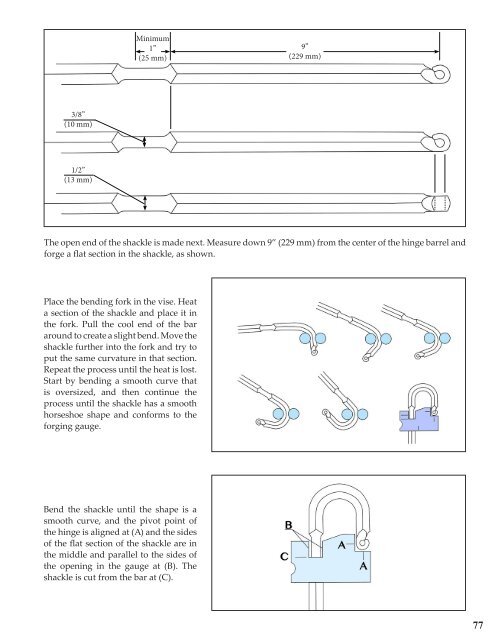The New Spruce Forge Manual of Locksmithing: A Blacksmith’s Guide to Simple Lock Mechanisms
The New Spruce Forge Manual of Locksmithing: a Blacksmith’s Guide to Simple Lock Mechanisms is a totally revised and expanded version of the original work from 1999. This new hardcover edition, at 304 pages and with more than 800 color photos and illustrations, is more than double the size of the original manual. It is divided into two distinct sections: Technical Information - This section is a reference manual in itself that covers the specific tools and techniques needed to build all the parts for each lock, as well as providing the information needed to understand the assembly instructions outlined in the second section. The Locks: Patterns & Instructions - This section provides the plans and detailed instructions for each of the 14 lock projects in this new edition. The clear assembly instructions describe when and how to use the technical information provided in section one. The authors have maintained their original trademark style that relies on well-illustrated step-by-step instructions that guide you through the whole lock-making process. They have also kept their low-tech approach that demonstrates how to go about creating good work using only a handful of simple tools. Making blacksmith locks is an age-old skill the authors of this manual are helping to preserve by passing on their knowledge to this book’s readers. The New Spruce Forge Manual of Locksmithing is also an excellent introduction to benchwork, which is a useful skill for any blacksmith to acquire. This manual will become a valuable, trusted and often referred to sourcebook in your blacksmithing library. Hardcover, 304 pages, more than 800 photos and illustrations.
The New Spruce Forge Manual of Locksmithing: a Blacksmith’s Guide to Simple Lock Mechanisms is a totally revised and expanded version of the original work from 1999. This new hardcover edition, at 304 pages and with more than 800 color photos and illustrations, is more than double the size of the original manual.
It is divided into two distinct sections:
Technical Information - This section is a reference manual in itself that covers the specific tools and techniques needed to build all the parts for each lock, as well as providing the information needed to understand the assembly instructions outlined in the second section.
The Locks: Patterns & Instructions - This section provides the plans and detailed instructions for each of the 14 lock projects in this new edition. The clear assembly instructions describe when and how to use the technical information provided in section one.
The authors have maintained their original trademark style that relies on well-illustrated step-by-step instructions that guide you through the whole lock-making process. They have also kept their low-tech approach that demonstrates how to go about creating good work using only a handful of simple tools.
Making blacksmith locks is an age-old skill the authors of this manual are helping to preserve by passing on their knowledge to this book’s readers. The New Spruce Forge Manual of Locksmithing is also an excellent introduction to benchwork, which is a useful skill for any blacksmith to acquire. This manual will become a valuable, trusted and often referred to sourcebook in your blacksmithing library.
Hardcover, 304 pages, more than 800 photos and illustrations.
Create successful ePaper yourself
Turn your PDF publications into a flip-book with our unique Google optimized e-Paper software.
Minimum<br />
1”<br />
(25 mm)<br />
9”<br />
(229 mm)<br />
3/8”<br />
(10 mm)<br />
1/2”<br />
(13 mm)<br />
<strong>The</strong> open end <strong>of</strong> the shackle is made next. Measure down 9” (229 mm) from the center <strong>of</strong> the hinge barrel and<br />
forge a flat section in the shackle, as shown.<br />
Place the bending fork in the vise. Heat<br />
a section <strong>of</strong> the shackle and place it in<br />
the fork. Pull the cool end <strong>of</strong> the bar<br />
around <strong>to</strong> create a slight bend. Move the<br />
shackle further in<strong>to</strong> the fork and try <strong>to</strong><br />
put the same curvature in that section.<br />
Repeat the process until the heat is lost.<br />
Start by bending a smooth curve that<br />
is oversized, and then continue the<br />
process until the shackle has a smooth<br />
horseshoe shape and conforms <strong>to</strong> the<br />
forging gauge.<br />
Bend the shackle until the shape is a<br />
smooth curve, and the pivot point <strong>of</strong><br />
the hinge is aligned at (A) and the sides<br />
<strong>of</strong> the flat section <strong>of</strong> the shackle are in<br />
the middle and parallel <strong>to</strong> the sides <strong>of</strong><br />
the opening in the gauge at (B). <strong>The</strong><br />
shackle is cut from the bar at (C).<br />
77










